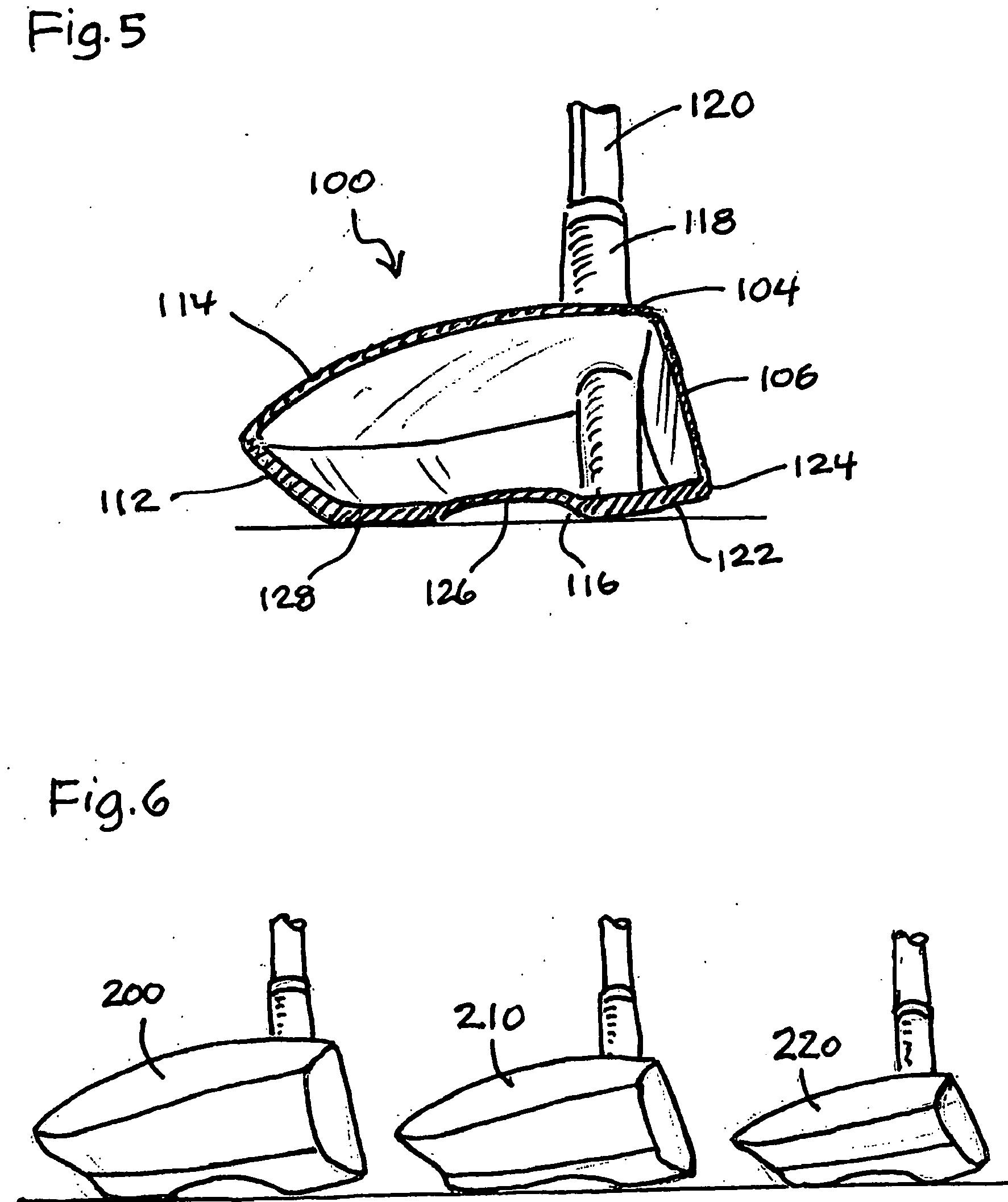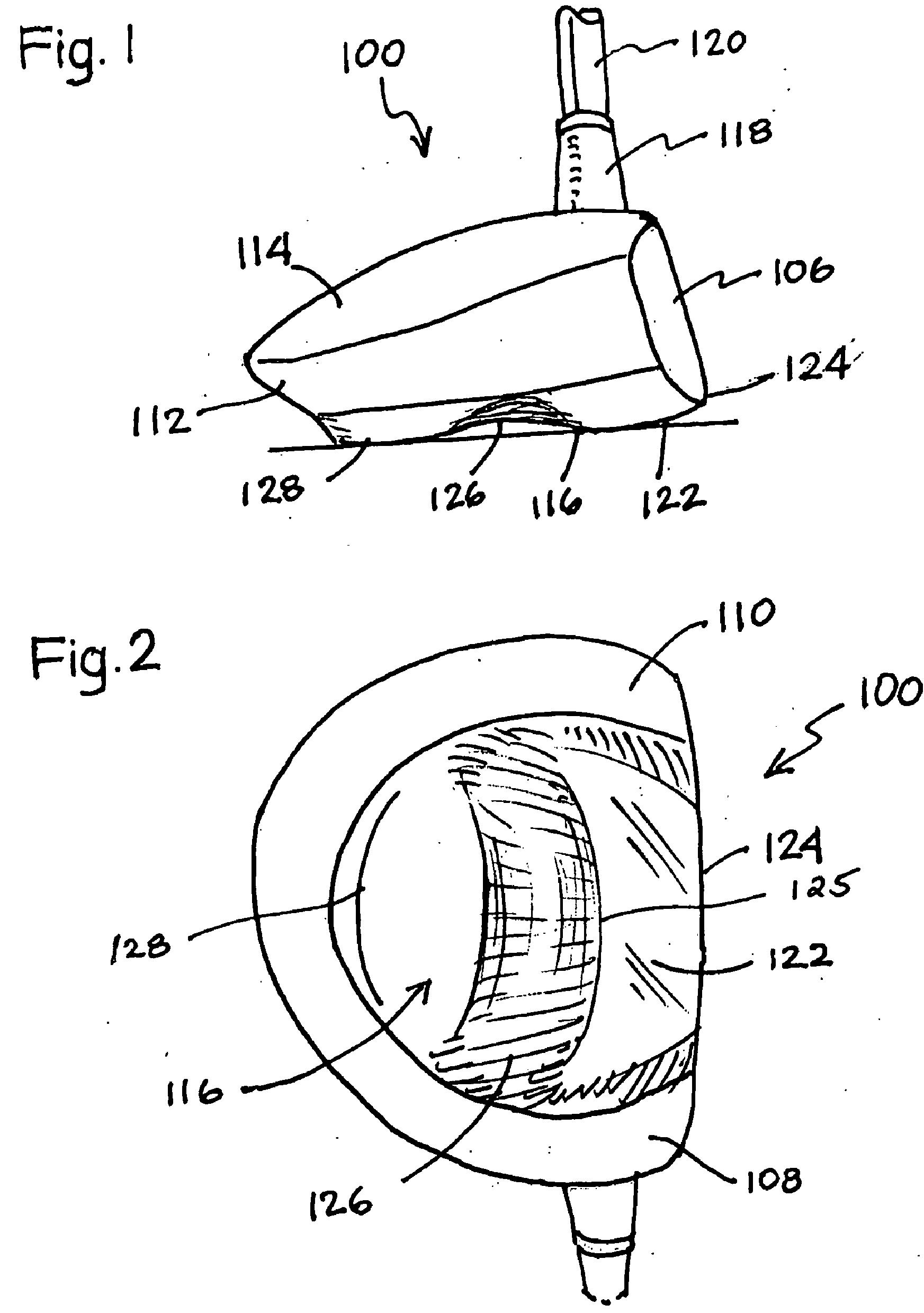Have You Seen the New Rife Drivers?
Well, neither have I…. but a recently published patent application may indicate that Rife Putters is looking to branch out. Today Mr. Rife had a patent application publish that may give us an idea of what he has been thinking about; namely, the soles of metal woods.
The patent application publishes as US Pub. No. 20090124410 titled “Sole Configuration for Metal Wood Golf Club.” The application describes the invention as:
A metal wood type golf club head including a club head body and means for attachment to a golf shaft, the club head body including a frontal ball striking face having a center of percussion thereon, a rear face, a heel, toe, and top crown, and a rigid, non-deformable bottom sole having a forward section and at least one additional rear section. The forward section provides a friction surface and is defined by a bounce angle extending downwardly from said frontal ball striking face to prevent the leading edge of the club head from digging into the turf or ground during the execution of a golf shot. The rear section of the bottom sole is a reduced friction surface and is recessed upwardly into the club head.
The application goes on to explain:
[0003] The way the sole of a golf club impacts the ground surface during the execution of a golf shot often determines the ball flight and the overall results of the shot. When the impact of the golf club on the ground surface creates a divot, mis-hits often occur. The leading edge of a golf club head is the edge at the interface of the bottom sole and lower portion of the ball striking face. It is well known in order to prevent the leading edge from digging into the ground at impact with a golf ball, the bottom sole configuration is formed with a downwardly extending, angular surface toward the rear edge of the club head that raises the leading edge above the ground. This is known in the art as the bounce of the club head, the bounce angle being the angle of the bottom sole relative to the horizontal when the club head is in a normal address position prior to the execution of a golf swing. Therefore, golf clubs with different bounce characteristics will react differently with the ground surface as the club head impacts with the ground during a golf shot.
[0004] Typically, a golf club with a higher bounce angle is considered to have more bounce. Typical bounce angles vary between 6 and 12 degrees. However, the effective bounce of a club head may also vary by changing the overall length of the bounce surface that engages the ground. For example, a larger bounce angle combined with a shorter bounce surface will create the same effective bounce as a lesser bounce angle with a wider ground engaging surface, since each structure will raise the leading edge of the club head the same height above the ground support surface. Bounce is particularly useful for golf clubs that are used to hit shots out of sand bunkers to enable the club to be swung down and through the sand without digging too deeply therein.
[0005] Even when a golf ball lies on smoothly cut grass or turf, the bounce and sole configuration will affect the results of the golf shot. This is particularly true when more severe conditions are encountered, such as extremely hard or soft surfaces. For example, when a golf club impacts a hard surface, the club head will tend to bounce resulting in the golf ball being hit thin resulting in a lower golf shot. When a ground surface is soft, a golf club may embed in the ground resulting in the loss of club head speed causing the golf ball to fly short of the intended target. Prior art golf club heads have been made with bottom sole configurations to control the way a golf club head reacts with the ground for the purpose of better controlling a golf shot.
[0006] Bounce angles are well known on iron type golf club heads, particularly on sand wedges. The bounce of these wedges prevents the leading edge of the club from digging into the sand thereby allowing a golfer to hit behind the ball and still be able to swing through the shot to extract the ball from the sand onto the green putting surface.
[0007] Wood type golf club heads are not provided with the bounce structure. Tsurumaki 2004/021852 discloses a wood type golf club head that is specifically designed to collapse when it strikes a golf ball. Tsurumaki shows a sole with a flat, angled forward section, a recessed mid-section and a rear section capable of testing on the ground. However both the structure and function of this sole configuration does not provide bounce. Rather the sole is designed to collapse change the club face angle when it strikes the ground.
SUMMARY OF THE INVENTION
[0008] The present invention is a metal wood type golf club head of conventional design with an improved sole configuration to increase the effective bounce of the club head. The bottom sole surface is rigid and non-deformable and formed in separate sections. A first forward sole section is located directly behind the leading edge of the club head and extends partway to the rear of the club head. The forward sole section is formed of a generally flat or planar land area at an angle downward from the horizontal when the club head is in a normal address position just prior to the execution of a golf shot. This angle is the bounce angle and raises the leading edge above the ground surface. The bounce angle allows the club to hit a golf ball off of a ground surface without taking a divot. The forward section provides a non-deformable, frictional surface that impacts the ground as a golf ball is hit with the club head. Because the sole is rigid, the bounce angle of the forward section prevents the club head from digging into the turf or ground and actually causes the club head to bounce. The bottom sole includes at least a second section behind the forward sole bounce section. The second section extends upwardly and inwardly and recesses into the club head body so it is raised above the ground surface with the club head at the address position. There is less friction on the second section surface since it is raised relative to the ground as a golf ball is hit by the club head. The raised second section preferably has an aerodynamic or airfoil shape that traps air between the bottom sole and ground creating lift and increasing club head speed.
[0009] Another feature of the sole structure is increased mass low on the club head because of the increased surface area and thickness of the metal wood shell in the lower areas. The increased thickness adds to the rigidity of the sole structure. This produces a higher trajectory ball flight for a given loft angle of the clubface. This, in turn, allows for a lower loft angle for a given ball flight resulting in increased distance for a given swing force. Because of this combination of bounce, loft angle and lower weight, lower lofted clubs, such as drivers, may be used in the fairway resulting in longer golf shots for a given swing force.
So, is Guerin onto something new, or should he stick with designing putters?
Dave Dawsey – Watching Golf Patents
PS – check out interesting putter patents HERE


